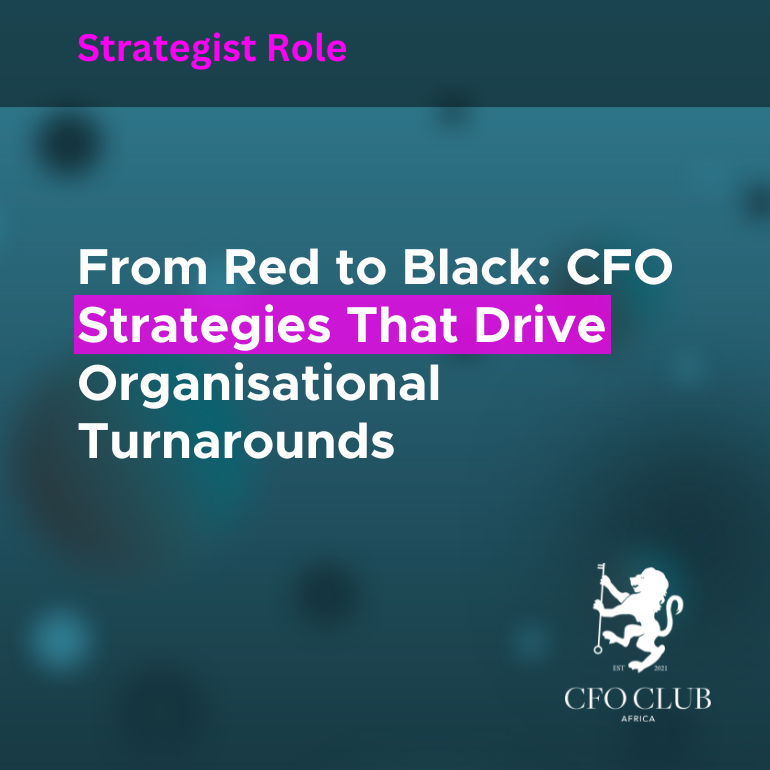From Red to Black: CFO Strategies That Drive Organisational Turnarounds
From Red to Black: CFO Strategies That Drive Organisational Turnarounds
When an organisation faces financial distress, the Chief Financial Officer becomes a pivotal figure in determining whether the business continues to decline or begins the path to recovery. Leading a company from financial loss to profitability requires far more than cost-cutting or boosting revenue. It involves a strategic rethinking of the business model, disciplined execution, and consistent leadership. A successful turnaround depends on restoring trust, re-establishing control, and redefining how value is created.
A turnaround begins with establishing clarity. Without a detailed understanding of what is broken, what can be fixed, and what must be discontinued, strategic efforts may become scattered and ineffective. The CFO is responsible for uncovering the true financial drivers of the organisation. This includes digging beneath high-level reports to understand where the organisation creates value, where it loses value, and how its performance is truly measured.
Understanding the True Economics of the Business
Many struggling businesses operate with internal reporting structures that conceal more than they reveal. When costs are misallocated or revenue is recognised inconsistently across different business units, the resulting picture is unclear. A CFO must prioritise financial transparency, not as a compliance issue, but as the foundation of accurate and confident decision-making.
In the early stages of a turnaround, a finance leader often needs to challenge long-held assumptions about the profitability of business units, the viability of projects, and the cost of continuing legacy operations. Only when leadership can see a clear and accurate picture of the business can the organisation begin to shift its trajectory.
Reallocating Capital with Discipline
Once the true financial position is understood, the next step is to reallocate capital toward areas that generate value. This process involves making difficult decisions. Some units may no longer be viable, and not every investment can continue. The CFO must be willing to question past decisions, assess current performance honestly, and make choices that prioritise long-term sustainability.
Effective capital allocation means each initiative must justify its continued funding. If a project is not delivering results, it must be reconsidered. Maintaining underperforming projects in the hope they will eventually improve often results in wasted resources. Instead, redirecting capital to profitable areas strengthens the organisation and improves overall resilience.
Empowering Teams to Make Better Decisions
In many turnaround situations, centralised control has increased in an effort to manage risk or contain costs. However, excessive centralisation often leads to bottlenecks, indecision, and reduced accountability. The CFO must recognise when the operating model itself is part of the problem.
Empowering business units with autonomy, while providing them with clear financial targets and reliable support systems, allows for faster decision-making and improved results. A decentralised approach supported by strong financial oversight creates a sense of ownership and encourages proactive leadership throughout the organisation.
Communicating the Strategy with Consistency
Recovering from financial difficulty is not only a technical process. It is an emotional and cultural journey for everyone involved. Staff may feel anxious about job security, stakeholders may have lost confidence, and the broader business community may be sceptical about the company’s future. In this context, the CFO must serve as a credible and consistent voice.
Communication must be clear, frequent, and meaningful. The CFO should explain not only what decisions are being made, but why they are necessary and how they contribute to long-term goals. When people understand the reasoning behind difficult changes, they are more likely to support them. Transparency also helps rebuild internal trust and maintains morale during periods of uncertainty.
Recognising Progress and Building Momentum
Progress in a turnaround is rarely immediate or dramatic. However, recognising incremental improvement plays an important role in rebuilding momentum. Each quarter that shows signs of growth—whether in cost savings, improved cash flow, or increased market confidence—should be acknowledged.
These acknowledgements are more than symbolic. They demonstrate that the plan is working, reinforce team efforts, and help the organisation regain confidence in its direction. The CFO can play a leading role by making results visible and ensuring that successes are recognised across all levels of the business.
Strengthening the Finance Team
A successful turnaround requires a capable and agile finance team. The CFO must evaluate whether the current team has the right skills, mindset, and capacity to support the recovery process. This may involve retraining staff, recruiting new talent, or redefining roles to better align with the organisation’s strategic priorities.
Beyond technical proficiency, the finance function must become a true partner to the business. This means collaborating closely with operations, human resources, procurement, and sales teams. Rather than acting as a control function only, finance should provide insight, build models, and help track the financial impact of strategic decisions in real time.
Leading with Empathy and Integrity
The most difficult part of any turnaround is managing its human impact. Cost reductions and restructurings affect real people. The CFO must maintain a sense of empathy and communicate with dignity and respect. Being honest about the business’s challenges, while remaining compassionate and solution-focused, strengthens the organisation’s long-term culture and reputation.
Financial recovery is not just about the numbers. It is about preserving the integrity of the business, supporting its people, and building a foundation for sustainable growth.
The Role of the CFO in Long-Term Recovery
Moving from red to black is not a quick fix. It requires sustained effort, strategic focus, and the ability to navigate uncertainty. The CFO plays a central role in this process by leading with clarity, making informed decisions, and supporting the organisation through both challenge and change.
A turnaround is ultimately a test of leadership. It calls for discipline, communication, and courage. When the CFO brings these qualities to the forefront, the organisation is better equipped to recover, rebuild, and re-emerge stronger than before.





